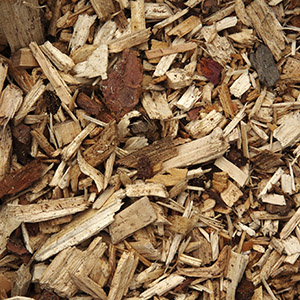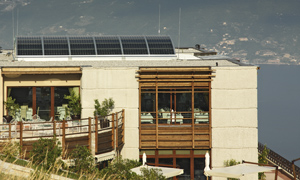Le Fay
LEFAY RESORT & SPA LAGO DI GARDA
Everything is too nice for words.
ENERGY SAVING
The use of state-of-the-art technologies targeted to reduce energy
consumption has allowed us to combine luxury, maximum service
and comfort with a comprehensive respect for the environment; at
this end, an efficient use of energy and a smart exploitation of clean
and renewable energy sources have been the key enabling factors.
Technology Facilities
The planners had to face two considerable challenges: the plan of the
technology units operating in the Resort and the design of the various
buildings. Their commitment to reduce the environmental impacts as
much as possible has resulted in a real power plant built at the back
of the Resort. It hosts all the most advanced systems for the production
of electrical energy, heating and cooling and is made of three main
plants:
- Biomass Plant
- Micro-turbines cogeneration plant
- Absorption cooling system
Biomass Plant
 A biomass plant fed by wood chips has been installed
A biomass plant fed by wood chips has been installed
to produce thermal energy. It significantly reduces
the carbon dioxide emissions and allows to optimize
the use of the wood of this area minimizing the
environmental impact. As for the stock up on
biomass, the usage of woods and remains of
gardening implies a strong involvement of the
local
agriculture.
With a production of thermal 720 Kwh, the biomass
plant covers about 70% of the thermal energy
demand of the Resort, namely heating rooms,
swimming pools and producing sanitary warm water.
The biomass plant allows an annual oil saving of
about 220,000 liters that means an annual CO2
emission reduction worth about 510 tons.
Micro-turbines cogeneration plant
Next to the biomass plant, we have built a cogeneration plant for
the combined production of electrical and thermal energy. The plant
is made of two identical micro-turbines fed by methane gas; there is an
electric generator, a heat-exchanger and a control and supervision system.
The heat produced by the micro-turbines is used to power the heating system
in the winter as well as the absorption cooling system in summer. The
whole plant can yearly produce about 1,100 Mwh of electrical energy and about
1,900 Mwh of thermal energy, thus reducing the CO2 emission of about
380 tons/year. Moreover, the micro-turbines are optimized in order to
operate in compliance with the minimum limits for exhaust emissions.
Absorption cooling system
The cooling production is covered for about 75% by an absorption cooling
system, which can be considered the real plus of Lefay Resort & SPA Lago di Garda;
as a matter of fact, this technology plant is one of the few in Italy and it enables
to generate cooling by using the heat exhausted through the micro-turbines and the
biomass boiler.
The remaining 25% cooling is produced by a high-performance compression
cooling system.
Methane powered boiler
In order to cover the remaining 10% of the annual energy consumption, a
methane powered boiler has been installed. This serves also as a security system
in case of breakdowns or extraordinary repairs carried out to other systems.
Solar and photovoltaic panels
 Our guests are going to be deeply impressed by the photovoltaic
Our guests are going to be deeply impressed by the photovoltaic
plant placed above the dining room - to the extent that they
can see it. The cupola is in fact completely made of photovoltaic
panels; in addition to their decorative function, it also serves
as shading system, thus avoiding overheating in summer and
providing an atmosphere similar to an airy and bright pergola.
The plant can produce about 12,200 kwh/year of electric energy
and together with the micro-turbines, it ensures about 60% of
the demand for electric energy, while the remaining 40% is
supplied by the electric energy network.
The thermal-solar plant is still under planning: it will be built
during the second phase of the project and it will be installed
on the roofs of the thermal plant/facility. Its thermal energy
will be used to produce sanitary warm water and for
swimming-pool heating.
Operational Software
Further saving potentials are provided by various operational software
implemented in the Resort; in particular, the daytime light control is managed
by a dedicated software which receives information about natural light from a
heliometer installed on the roof. The system allows reducing the artificial
lighting levels when sufficient natural light is available, as well as during the
night or in case of scarce use.
Moreover, the lighting of common areas and walkways is operated by a presence
or movement detector, while outdoor areas feature lighting parts directing the shaft
of light only where it is needed, without dispersions. Light and shadow upon request
provide a particular ambience and allow energy saving.
In addition to this, there is also a facility for the optimization of electrical
loads and control of withdrawal peaks. The power absorbed by all the electrical users
is continuously monitored by the software which compares it with predefined maximum
values; in case of overload and consequent exceeding of the values set, the system
controls the partial or entire disconnection of users and groups of selected users
according to a specified priority scheme.
Energy saving and reduction of CO2
emissions (carbon dioxide emissions)
At present, the share of renewable energy sources at Lefay Resort
& SPA Lago di Garda amounts to about:
- 93% for thermal energy production used for heating, hot water
production and swimming pools - 75% for room cooling
- 75% for air cleaning
- 60% for electric energy production
In addition, the use of renewable sources of energy and innovative and
advanced technologies enables to dramatically reduce CO2 emissions
(carbon dioxide emissions) and to achieve a global reduction in
emissions of 1,130 tons per year.
